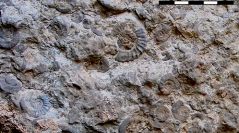

 European Journal of Taxonomy
776 (1) - Pages 1-106
European Journal of Taxonomy
776 (1) - Pages 1-106The Changhsingian (Late Permian) Hambast Formation of sections at Baghuk Mountain (Central Iran) has yielded diverse ammonoid assemblages composed of the genera Pseudogastrioceras, Shevyrevites, Arasella, Dzhulfites, Paratirolites, Clivotirolites gen. nov., Esfahanites gen. nov., Alibashites, Lutites gen. nov., Abichites and Stoyanowites. The succession of ammonoid species allows for a subdivision of the rock unit into biozones, which largely correlate with the occurrences in north-western Iran. Three new genera, Clivotirolites Korn & Hairapetian gen. nov., Esfahanites Korn & Hairapetian gen. nov. and Lutites Korn & Hairapetian gen. nov., as well as 19 new species are described: Shevyrevites corrugatus Korn & Hairapetian sp. nov., Arasella falcata Korn & Hairapetian sp. nov., Dzhulfites brevisellatus Korn & Hairapetian sp. nov., Paratirolites rubens Korn & Hairapetian sp. nov., Paratirolites lanceolobatus Korn & Hairapetian sp. nov., Paratirolites robustus Korn & Hairapetian sp. nov., Paratirolites baghukensis Korn & Hairapetian sp. nov., Paratirolites aduncus Korn & Hairapetian sp. nov., Clivotirolites decoratus Korn & Hairapetian gen. et sp. nov., Clivotirolites petilus Korn & Hairapetian gen. et sp. nov., Esfahanites armatus Korn & Hairapetian gen. et sp. nov., Lutites paucis Korn & Hairapetian gen. et sp. nov., Lutites lyriformis Korn & Hairapetian gen. et sp. nov., Lutites profundus Korn & Hairapetian gen. et sp. nov., Lutites alius Korn & Hairapetian gen. et sp. nov., Lutites plicatus Korn & Hairapetian gen. et sp. nov., Abichites ovalis Korn & Hairapetian sp. nov., Abichites infirmus Korn & Hairapetian sp. nov. and Stoyanowites parallelus Korn & Hairapetian sp. nov. The material described here is, together with the material from NW Iran, the most diverse assemblage known from the interval before the end-Permian mass extinction.